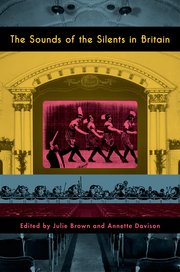The Sounds of the Silents in Britain
The Sounds of the Silents in Britain, edited by Julie Brown and Annette Davison. (Oxford University Press, 2013). 352 pages. ISBN: 978-0199797615 (hardback), £65; ISBN: 978-0199797547 (paperback), £22.50.
 About the reviewer: Michael Williams is a Senior Lecturer in Film at Southampton University. His latest book is Film Stardom, Myth and Classicism: The Rise of Hollywood’s Gods (Palgrave Macmillan). Some of his other publications include: British Silent Cinema and the Great War (Palgrave Macmillan, 2011); Ivor Novello: screen idol (British Film Institute, 2003); The idol body: stars, statuary and the classical epic. Film & History, 39, (2), 39-48. (doi:10.1353/flm.0.0120).
About the reviewer: Michael Williams is a Senior Lecturer in Film at Southampton University. His latest book is Film Stardom, Myth and Classicism: The Rise of Hollywood’s Gods (Palgrave Macmillan). Some of his other publications include: British Silent Cinema and the Great War (Palgrave Macmillan, 2011); Ivor Novello: screen idol (British Film Institute, 2003); The idol body: stars, statuary and the classical epic. Film & History, 39, (2), 39-48. (doi:10.1353/flm.0.0120).
The Sounds of The Silents in Britain is an important collection on a neglected field; exploring the diverse sonic dimensions of cinema as it developed across the era leading up to synchronised sound, presenting a richly evocative array of ephemeral cultural practices.
The past few years have seen a resurgence of interest in silent film. This is the product of much hard work by archivists, scholars and musicians in bringing cinema’s past back to vibrant and noisy life through festivals and publications, given added momentum by recent high-profile films such as The Artist and Hugo, and DVD and Blu-ray releases offering multiple commentary and music options. Indeed, the digital technologies that today pertain to construct a more immersive, attention-grabbing, cinema experience, finds strange resonances with the wonderful array of ephemeral cultural practices explored in this book, whether directing, controlling or enabling attention and social interaction in the cinema. Reading this book, one a gets a feeling for how rich and strange the cinema experience was for audiences in the early decades of cinema, and how full of sound in so many forms. The ‘silent’ auditoria thus evoked in the book’s essays emerge as Protean, immersive, and often very social, spaces that could experiment with new techniques and technologies, and respond to the needs of different audiences. If these essays evoke a tension between social and personal engagement, and different agencies competing for attention, whether the screen, or a lecturer, music or the audience themselves, these resonate as very modern concerns.
 While paying homage to pioneers in the field, such as Rick Altman, the new research presented here refines and often challenges conventional thinking about the development and practices in sound and music. Jon Burrows’ research, in particular, uses a close examination of cinema licensing records in London to indicate how few cinemas attempted to synchronise music to image before 1910, and that small orchestras, rather than lone pianos, were soon in much wider use than previously thought. As with Andrew Higson’s chapter, this research shows how it was rarely standard practice to closely follow the narrative of images on screen with music, which was even considered ‘bad policy.’ Audiences evidently experienced great variation between venues as to the kind of accompaniment they might experience, subject to divergent historical, and critical, preconceptions as to what might constitute ‘suitable music.’ The contributors show just how varied the role played by a lecturer, whose words could be in enabling a performative cinematic space, could be, whether or not they became the ‘terroristic mood setter,’ described in one marvellous description quoted by Judith Buchanan. Stephen Bottomore presents a fascinating case study of live sound pioneer, Eric Williams, who impressed audiences by his ability to lip-sync characters he played on screen; an elegant blurring of the line between screen persona and live appearance.
While paying homage to pioneers in the field, such as Rick Altman, the new research presented here refines and often challenges conventional thinking about the development and practices in sound and music. Jon Burrows’ research, in particular, uses a close examination of cinema licensing records in London to indicate how few cinemas attempted to synchronise music to image before 1910, and that small orchestras, rather than lone pianos, were soon in much wider use than previously thought. As with Andrew Higson’s chapter, this research shows how it was rarely standard practice to closely follow the narrative of images on screen with music, which was even considered ‘bad policy.’ Audiences evidently experienced great variation between venues as to the kind of accompaniment they might experience, subject to divergent historical, and critical, preconceptions as to what might constitute ‘suitable music.’ The contributors show just how varied the role played by a lecturer, whose words could be in enabling a performative cinematic space, could be, whether or not they became the ‘terroristic mood setter,’ described in one marvellous description quoted by Judith Buchanan. Stephen Bottomore presents a fascinating case study of live sound pioneer, Eric Williams, who impressed audiences by his ability to lip-sync characters he played on screen; an elegant blurring of the line between screen persona and live appearance.
This reminds me that there is more research to be done on the relationship between the aural and imagined ‘voice persona’ of the star into the 1920s. We also encounter the film prologues explored by Julie Brown, an art in which Britain seems to have briefly pioneered, and the wonderful merging of film and audience performance in the Singalong films discussed by Malcolm Cook, the latter showing how technology can both enable community interaction while at the same time increasingly controlling the way audiences behave through synchronised sound. Other topics covered include Annette Davison’s excellent work on an important issue for musicologists, worker’s rights and performing rights; James Buhler on the reception of British cinema practices in Moving Picture World; John Riley on different approaches to sound taken by the Film Society in London; and Fiona Ford on how the Austrian composer Edmund Meisel approached synchronised sound.
The collection demonstrates the value of contemporary sources, including the trade press, official records, newspapers and fiction, to illuminate both actual or ideal contemporary practices and key matters of regulation (national and local) that controlled what music may, or may not, be heard in the auditorium. The book stays true to its stated desire to look beyond the film text, though there are instructive textual references throughout, all supported by instructive illustrations. The editors’ ‘Overture’ provides an excellent introduction to the collection and its significance. However, I would have liked to seen a little more said about the periodization of the collection, which ranges from the late 19th century right up to the early 1930s, where a little more signposting would help further integrate, for example, Derek B. Scott’s interesting work on the neglected field of musical shorts in the early 1930s. The collection clearly benefits from an unusually strong sense of interconnection between the chapters, with frequent cross-referencing and everywhere an awareness of collective purpose. This reflects the skill of the editors as well as the kind of collaborative endeavour between scholars, archivists and other specialists fostered by the British Silent Film Festival and the Sounds of Early Cinema in Britain research network.
The Sounds of the Silents in Britain presents a complex story in an engaging and accessible fashion
The Sounds of the Silents in Britain presents a complex story in an engaging and accessible fashion, with an intelligently light touch taken, in general, with regard to theory. It is sure to become a valuable resource for film and music scholars, students and, indeed, anyone interested in this extraordinarily vibrant period of cinema. With its wonderful array of chapters (particularly Burrows and Kember) there is no excuse not to add the sound of silent cinema to any university module exploring this period of film and sound history. One closes the book having felt that its authors have enabled the reader to vicariously experience at least part of the dynamic and rather wonderful sounds of the silents.
Michael Williams
 Learning on Screen
Learning on Screen